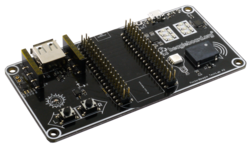As you might know, the BeagleBoard.org Foundation is dedicated to education in and collaboration around the design and use of open-source software and hardware in embedded computing. For me, this mission really is world changing important. Every aspect of our lives is impacted by embedded computing technology constantly, yet most people are barely literate in computer science. In 2020, I resolve to do more to educate the world about why this mission is so very important.
I’ll break down my 2020 resolution plan into three (3) areas: digital ownership, online training and where I’m working to contribute. I will use this blog to cover the whys, hows and whats of embedded computing in some consumable and actionable ways.
My goal is nothing less than reinventing the Internet and our digital lives, but I’ll need to bring you along to make it happen.
Let’s start with why this transformation needs to take place and why you need to be a part of it.
Digital ownership
In my series on digital ownership, I’ll be doing a bit of digital hygiene of my own and sharing my experience. This will be an exploration of what is possible today and why it can be so much better. I hope you can imagine what digital hygiene might be. If not, I hope it suffices to say that I’ll be talking a lot more about my on-line accounts and digital photo albums than I will about my dentist’s phalanges.
The focus is on ownership–as in real, practical control, which can often be more interesting than legalistic ownership. After all, many have said that possession is 9/10ths of the law. Still, there is that pesky 1/10th sitting around just waiting to get invoked by someone. Building up a bit of understanding is a simple necessity for everyone.
What can be taken away from you? What can simply be lost? You know, clouds are physical objects made of water and dust. The analogy to computing holds as cloud computing is made of physical computers, disk drives and network cables sitting in a data center warehouse that can fail and be controlled by companies and individuals. They do smart things to keep your data safe and secure, but there’s nothing magical. Some Beagle-related projects like Freedombone and The Deck have already been providing some of the critical tools, but much work remains. I’ll be taking a long look at what is practical today.
Online training
There is a LOT of material out there on using Beagles, but often users don’t know what is accurate or available within the latest software images without attending a workshop. Meanwhile, people getting started on their own are focused on different tasks and using different materials. I can only personally participate in so many workshops a year. Why not run a few online workshops so many of us can all get started together and share our experience?
These online training workshops will start pretty basic, covering some fundamental computer science and electronics, without a whole lot of depth. If you already have some of the basics, I suggest you start from the beginning with the rest of us, as we’ll get pretty deep pretty fast. In fact, the first workshop series will go as far as creating new Linux kernel drivers and working with physical interfaces. You’ll also want to pay attention to the first sessions to get familiar with the hardware we will be using for the workshop series.
I’m looking to try to run about 5 online workshop series in 2020, so I’ve got my work cut out for me. Each series will use a different kit of parts. We’ll make sure distributors have a good amount of stock and give everyone a couple of weeks to pull the parts together, as well as provide shortcut links if you want to buy the parts all in one spot.
The first series will be using PocketBeagle TechLab Cape. The more formal announcement will be in late February (after Embedded World). Each week, I will make a blog post that will include a video for that week’s lecture. There will be a live-airing time scheduled for logged live-chat Q&A via #beagle on IRC. A section of the BeagleBoard Google Group will be used for questions about the lecture, lab assignments and hardware. The agenda will be prepared, but since we will be working as a community, it can be adjusted somewhat based on feedback. I’m expecting to take about 1-2 hours of your time a week to keep up with the workshop series for us all to stay on the same pace. For some of you, just watching the lecture will be enough, but let’s try to keep the discussion timely as community developed projects change over time and you don’t want to be left behind.
Subsequent sections will be based on PocketBeagle Grove Cape, BeagleBone AI, BlueDonkey (either BeagleBone Blue or BeagleBone AI with BeagleBone Robotics Cape) and PocketBeagle GamePup. Each will start from scratch, but don’t worry, I’ll make sure each is covering new ground as well. While there will indeed be a lot of material covering hardware specifics, common hardware is a means, not an end, to the teaching topics. Each series will cover specific fundamentals that will serve you on any hardware or software. A wide variety of sensors and actuators will help keep things fresh on each given embedded computing environment.
The end goal of these workshop series is to prepare as many people as possible to participate with BeagleBoard.org in making world a better place. For real, I do mean better. We’ll make the world a place where more of us can arrange the atoms and electrons in our lives to serve us as we see fit. We’ll also enable more people in the world to create technology that better serves their neighbors while it serves themselves. Doesn’t that sound better?
Direct contributions
Finally, I need to lead by example. For me, this doesn’t always mean directly writing code, but it does mean writing better problem statements so that people in the community, and those that want to join the community, know what improvements we are seeking to make in code. My contributions could also mean reaching out to contractors, or documenting progress that has already been made on code.
When starting BeagleBoard.org, I had my own ideas of what an Internet of Things framework would be. Seeing end products like the Creator cheeseburger robot built around BeagleBones really gives a more concrete idea what is possible and shows how Beagle has helped to evolve the creation of embedded systems over the last decade. While the state of the art isn’t a single application stack and has instead devolved into the orchestration of containers, much can be done to streamline the sensor-to-cloud pathway for Beagle users. That includes improvements from USB-based boot-loading and flashing and eliminating the need for device tree overlays to enable sensors all the way to better supporting containers, messaging and over-the-air updates. If no one else can bring an open source approach to develop software from tiny microcontroller systems, to signal board computers and on to cloud-based systems, then it seems we must.
But so much more needs to be done and we need your creativity and passion.
Conclusion
Wow, this blog post grew quickly! 2020 is here and I’m resolving to engage you through this blog regarding why we all need more embedded computing knowledge, how we can go about gaining that knowledge and what I’m doing with mine. Maybe I’ll set some good examples for you or learn ways to better tackle this mountain from you. In both cases, I look forward to all my interactions with the amazing BeagleBoard.org community this year, so let’s stay in touch.







